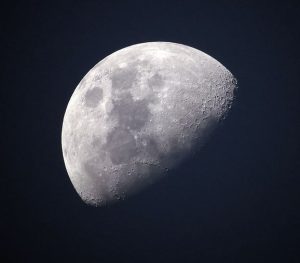
Art by Ofjd125gk87
By Jo Nova
In the next great environmental cult moment, “The Science” has a plan to explode a 10-billion-kilogram dust cloud off the moon between the Earth and the Sun. Shimmery white moon dust will dim the evil solar rays and “save us from our addiction to fossil fuels” (at least until we run out of Moon). The dust will disperse every couple of weeks, so we just need to keep topping up our global sunscreen by setting the explosives off. At least it probably won’t kill many whales.
The plan involves getting man back on the moon for the first time in fifty years, setting up a moon base, and a permanent mining colony, but (guard your coffee) — it might be cost effective:
Squirting a carefully calculated stream of Moondust from a future lunar station at the right point between the Sun and Earth might be the most cost-effective, risk-free means of keeping our cool until we come to our senses and cut emissions.
But not as cost effective as spending 0.000000001% of that to check the science and blow up a few climate models instead.
Because we all enjoyed the Little Ice Age, right?
Bromley notes the proposal would mimic the scenario that occurred during the Little Ice Age, when Louis XIV reigned over France. You’d need a lot of dust but, provided you could get it into space, it would essentially work to reduce solar radiation, blocking around 1% to 2% of the light.
What luck, God made the moon out of just the right cheese?
“Lunar dust stood out for two reasons,” said Bromley “First, it can be pretty efficient at deflecting sunlight, and second, it turns out that the most efficient grain size is the most plentiful on the moon’s surface.” This, he notes, was a fun surprise and something they didn’t know going into the project. One of the problems, though, is just how much dust is required. It would be cost prohibitive to constantly send rockets full of space dust to a platform out at L1, so the moon provides a second advantage.
Exploding bombs on the moon will either waste a continent worth of money or — if it works — make the Earth less habitable, reduce crops, increase frosts, and shrink coral reefs. But it will apparently “buy us time to mature as a society”. Put yourself in the naughty corner.
People in 100 years are going to find this very funny. Why wait? Laugh now…
Latest Mind-Blowing Suggestion For Cooling The Planet Involves Blasting The Moon
 Science Alert by MIKE MCRAE
Science Alert by MIKE MCRAE
With each passing year, the effects of rising global temperatures become even more obvious, while the chances of avoiding greater catastrophes in the future retreat like every melting glacier.
Desperate to avoid worst-case scenarios, researchers have proposed various measures that could, at the very least, buy us the time we might need to mature as a society and work to undo the damage.
Blasting a steady stream of dust from the surface of the Moon is the latest suggestion to get a solid scientific appraisal, with University of Utah computational astrophysicist Ben Bromley and computer scientist Sameer Khan and Smithsonian Astrophysical Observatory astrophysicist Scott Kenyon giving the idea a tentative thumbs up.
UPDATE: Think of what a nice bureaucratic model this is. NASA / ESA / NOAA gets more money to do what they want to do anyhow, and they can tweak the program to suit the weather. If the world cools they claim “success”. If the world doesn’t cool, they can point to how essential this program is to stop extreme heat. Give me your money… Whatever happens to the weather, the climate modelers will tell us how useful the moon dust was and another international bureaucracy is born.
Science communicators have mastered the art of treating adults like 6 year olds. Logic?
The logical thing to do would be to work together to kick our nasty habit of smoking fossil fuels. Shocking as it seems, it could be faster and easier to engage in mammoth-scaled engineering projects that literally reflect a proportion of sunlight before it hits Earth and is converted into a form that’s likely to stick around as heat.
Bromley, Khan, and Kenyon have done the math on the characteristics of a 10-billion-kilogram dust cloud doing much the same job.
The idea itself has been kicked around as a less intrusive version of sulfur being suspended in Earth’s atmosphere. It has benefits over more technical space-borne projects, relying on material that doesn’t require significant manufacture, doesn’t need to be launched from our surface, and doesn’t pollute our planet.
Assessing the shadow cast by different kinds of material, the impact of gravitational forces, radiation pressure from sunlight, and the smack of the solar wind, the researchers calculated the qualities and quantities of small rocky fragments required to filter out just under 2 percent of the Sun’s rays.
They showed the dust cloud would clear relatively quickly, depending on their size. Micron-sized grains would be pushed out of position within a week, requiring fairly regular top-ups. On the plus side, there’d be no need for adjustments to orbits should things go wrong. Just wait a few days for the fog to lift, and it’s business as usual.
REFERENCE (if you can call it that)
Bromley and friends (2023) Dust as a solar shield, PLOS Climate, https://doi.org/10.1371/journal.pclm.0000133
Photo by Ponciano